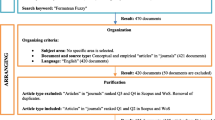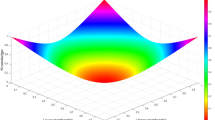Abstract
The aim of fuzzy intersection graph is twofold: to work with objects with continuum grades of membership and to acknowledge their inter-relationships. Its working elements are fuzzy logic and reasoning with the objective of providing accessible representation of objects and relationships having a blurry backdrop. This article embarked a comprehensive study of fuzzy intersection graph using fuzzy geometry by defining fuzzy graph and fuzzy intersection region with the help of fuzzy points and fuzzy line segments. The main motive behind revamping fuzzy graphs using fuzzy geometry is to represent the linguistic variables and their inter-dependencies as an exact reflection of human thinking. We have interpreted a detailed study on parallel fuzzy lines and intersecting fuzzy lines and deduced a mathematical relation between the measure of parallelness and degree of intersection of fuzzy lines. Fuzzy intersection region, depending on the types of intersecting fuzzy sets, plays an important role. We have defined few of the most important and useful classes of fuzzy intersection graph from fuzzy geometric view point that will be helpful in expressing human thoughts and communication of information as has been demonstrated through an application on supplier–purchaser relationship in any business. The present study on fuzzy interval graph in detail, ensued in obtainment of results that nullified previously obtained results arising the question—are fuzzy interval graphs always strong intersection graphs?





















Similar content being viewed by others
References
Ali S, Mathew S, Mordeson J (2020) Hamiltonian fuzzy graphs with application to human trafficking. Inf Sci. https://doi.org/10.1016/j.ins.2020.10.029
Atanassov KT (1999) Intuitionistic fuzzy sets. Studies in fuzziness and soft computing, vol 35. Physica, Heidelberg
Badaloni S, Giacomin M (2006) The algebra \(IA^{fuz}\): a framework for qualitative fuzzy temporal reasoning. Artif Intell 170(10):872–908
Bogomolny A (1987) On the perimeter and area of fuzzy sets. Fuzzy Sets Syst 23:257–269
Bucley JJ, Eslami E (1997a) Fuzzy plane geometry I: points and lines. Fuzzy Sets Syst 86:179–187
Bucley JJ, Eslami E (1997b) Fuzzy plane geometry II: circles and polygons. Fuzzy Sets Syst 87:79–185
Chaudhuri BB (1991) Some shape definitions in fuzzy geometry of space. Pattern Recognit Lett 12:531–535
Chakraborty D, Ghosh D (2012) Analytical fuzzy plane geometry I. Fuzzy Sets Syst 209:66–83
Craine WL (1994) Fuzzy hypergraphs and fuzzy intersection graphs. Doctoral thesis, Air Force Institute of Technology, Wright-Patterson. AFB, OH
Dubois D, Prade H (1980) Fuzzy sets and systems. Theory and applications. Academic Press, New York
Dubois D, Prade H (1989) Processing fuzzy temporal knowledge. IEEE Trans Syst Man Cybern 19(4):729
Fulkerson DR, Gross OA (1965) Incidence matrices and interval graphs. Pac J Math 15:835–855
Gani N (2011) On complete double irredundant sets in fuzzy graph. Int J Math Sci Eng Appl 5:429–435
Ghosh D, Chakraborty D (2015) On general form of fuzzy lines and its application in fuzzy line fitting. J Intell Fuzzy Syst 29(2):659–671
Ghouila-Houri A (1962) Caractérisation des graphes non orientés dont on peut orienter les arětes de manièreàobtenir le graphe d’une relation d’ordre. C R Acad Sci Paris 254:1370–1371 (French)
Gilmore PC, Hoffman AJ (1964) A characterization of comparability graphs and of interval graphs. Can J Math 16(539):548
Goetschel R, Voxman W (1983) Topological properties of fuzzy numbers. Fuzzy Sets Syst 10:87–99
Golumbic MC (1980) Algorithmic graph theory and perfect graphs. Academic Press, New York
Hajos G (1957) Über eine Art von Graphen. Int Math Nachrichten 11:65
McAllister MLN (1988) Fuzzy intersection graphs. Comput Math Appl 15(10):871–886
Mordeson JN, Nair PS (1996) Cycles and cocycles of fuzzy graphs. Inf Comput Sci 90:39–49
Mordeson JN, Nair PS (2000) Fuzzy graphs and fuzzy hypergraphs. Springer, Berlin
Mordeson JN, Mathew S, Malik DS (2018) Fuzzy graph theory with applications to human trafficking. Springer International Publishing, New York
Nair PS, Cheng SC (2001) Cliques and fuzzy cliques in fuzzy graphs. In: Joint 9th IFSA World Congress and 20th NAFIPS international conference. Vancouver. Canada, pp 2277–2280
Pal M (2013) Intersection graphs: an introduction. Ann Pure Appl Math 4(1):43–91
Pal M, Samanta S, Ghorai G (2020) Modern trends in fuzzy graph theory. Springer, New York
Pedrycz W (1995) Fuzzy sets engineering. CRC Press, Boca Raton
Pramanik T, Samanta S, Pal M (2014) Interval-valued fuzzy planar graph. Int J Mach Learn Cybern. https://doi.org/10.1007/s13042-014-0284-7
Raut S, Pal M, Ghorai G (2018) Fuzzy permutation graph and its applications. J Intell Fuzzy Syst 35:2199–2213
Rosenfeld A (1975) Fuzzy graphs. Elsevier, Amsterdam. https://doi.org/10.1016/B978-0-12-775260-0.50008-6
Rosenfeld A (1984) The diameter of a fuzzy set. Fuzzy Sets Syst 13:241–246
Rosenfeld A (1990) Fuzzy rectangles. Pattern Recognit Lett 11(677):79
Rosenfeld A (1994) Fuzzy plane geometry: triangles. In: Proceedings of 3rd IEEE international conference on fuzzy systems, vol 11, pp 891–893. Orlando. 26–29 June
Şahin M, Ulucay V (2019) Fuzzy soft expert graph with application. Asian J Math Comput Res 216–229
Sahoo S, Pal M (2015) Intuitionistic fuzzy competition graph. J Appl Math Comput 52:37–57
Samanta S, Pal M (2015) Fuzzy planar graphs. IEEE Trans Fuzzy Syst 23(6):1936–1942
Samanta S, Pal M (2016) A study on fuzzy graphs and their application. Lambert Academic Publishing, Saarbrucken (ISBN: 978-3-659-81607-9)
Schockaert S, De Cock M (2008) Temporal reasoning about fuzzy intervals. Artif Intell 172:1158–1193
Sun F, Wang X, Qu X (2016) Cliques and clique covers in fuzzy graphs. J Intell Fuzzy Syst 31:1245–1256
Talaee B, Nasiri G (2019) On intersection graph of intuitionistic fuzzy submodules of a module. Leban Sci J 20(1)
Uluçay V, Deli I, Şahin M (2018) Trapezoidal fuzzy multi-number and its application to multi-criteria decision-making problems. Neural Comput Appl 30(5):1469–1478
Voskoglou M (2017) Application of fuzzy numbers to assessment of human skills. Int J Fuzzy Syst Appl 6:59–73
West DB (2000) Introduction to graph theory, 2nd edn. Prentice-Hall, Englewood Cliffs, pp 224–226
Zadeh LA (1965) Fuzzy sets. Inf Control 8:338–353
Zadeh LA (1973) Outline of a new approach to the analysis of complex systems and decision processes. IEEE Trans Syst Man Cybern 3(1):28–44
Zadeh LA (1975) The concept of a linguistic variable and its application to approximate reasoning-Part 1. Inf Sci 8:199–249
Zadeh LA (2008) Is there a need for fuzzy logic\(?\). Inf Sci 178(13):2751–2779
Acknowledgements
The first author is thankful to the Department of Higher Education, Science and Technology and Biotechnology, Government of West Bengal, India for the award of Swami Vivekananda merit-cum-means scholarship (Award No.52-Edn (B)/5B-15/2017 dated 07/06/2017) to meet up the financial expenditure to carry out the research work.
Author information
Authors and Affiliations
Corresponding author
Additional information
Publisher's Note
Springer Nature remains neutral with regard to jurisdictional claims in published maps and institutional affiliations.
Rights and permissions
About this article
Cite this article
Raut, S., Pal, M. Fuzzy intersection graph: a geometrical approach. J Ambient Intell Human Comput 13, 4823–4847 (2022). https://doi.org/10.1007/s12652-021-03192-y
Received:
Accepted:
Published:
Issue Date:
DOI: https://doi.org/10.1007/s12652-021-03192-y




